- Home
- Technical Cooperation Projects
- Index of Countries
- Asia
- Mongolia
- The Project for Strengthening Teachers' Ability and Reasonable Treatments for Children with Disabilities (START) Phase 2
- Project News
- Inclusive Education Practices in Regular Schools in Mongolia
Project News
2022-06-13
Inclusive Education Practices in Regular Schools in Mongolia
The Project monitored 25 schools in Ulaanbaatar that implement inclusive education. In addition to providing individualized support for students with disabilities, the schools worked to create a school environment that is comfortable for all students enrolled in each school, and to introduce teaching methods for students to understand easily. The Project provided advice and support for the environmental improvement, individualized education plans, school committees, teaching methods, and parental support. Together with the district officers in charge of inclusive education, the Project visited each school in February and May 2022 to observe the results of their activities and to provide advice.
The spread of COVID-19 forced schools in Mongolia to close for a period. For some time after the resumption of face-to-face classes, the number of students attending school per day was cut in half. When the Project visited schools in February 2022, a lot of schools seemed not to know how to implement inclusive education.
Based on this situation, the Project provided online training for the schools and introduced specific practical methods during visits to the schools. In May 2022, when the Project visited the schools, we heard very positive comments from the teachers, such as, "Through inclusive education, I have been able to feel the student's growth very much," and "Communication among teachers has increased, they now work as a team, and their relationship with students has improved". Below, we would like to introduce some good examples from the 25 monitored schools regarding environmental improvement, teaching methods, and changing student attitudes toward inclusive education.
Environmental improvement
Each school has made environmental improvements such as installing handrails in corridors and stairways. One of the most important aspects of environmental improvement is to make it easy for all children to use them. Some schools actually asked their students about the size and comfort of the universal design toilet before renovation, while others installed a step to make it easier for younger students to use the washbasin and a wooden ramp to eliminate steps at the classroom entrance.
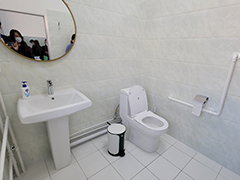 The toilet was made by actually asking the students how comfortable it is to use and adjusting the size and height. The placement of the toilet is suited to the child's height and movement.
The toilet was made by actually asking the students how comfortable it is to use and adjusting the size and height. The placement of the toilet is suited to the child's height and movement.
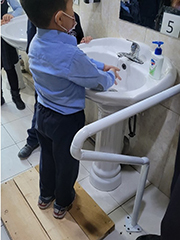 A step to make it easier for younger students to wash their hands. This stand allows them to wash their hands with a good view of their hands and without getting their sleeves wet.
A step to make it easier for younger students to wash their hands. This stand allows them to wash their hands with a good view of their hands and without getting their sleeves wet.
Teaching methods
In regular classes, a variety of students learn together such as students with disabilities and those who learn quickly. It is important to provide instruction that is easy to understand for all students and to create an environment where students can learn from each other.
In a classroom where a student with hearing impairment learns, she was surrounded by students who had a good understanding of contents of lesson. This allowed the surrounding students to assist the student with hearing impairment in learning. In addition, when the student herself does not understand a problem or is not confident in her answer, she is able to ask questions of the surrounding students on her own. This initiative fostered her spontaneity, improved her relationships with her friends, and gave her confidence in her daily life. Inclusive education also has a positive impact on parents in regular classes. In one school, several parents worked together to create enlarged textbooks that are easy to read for everyone.
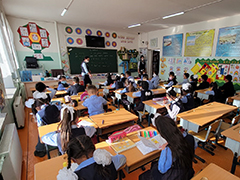 A class with the student with hearing impairment
A class with the student with hearing impairment
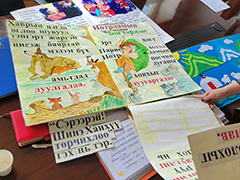 Enlarged textbooks that are easy to read for all students. The introduction of inclusive education also promoted parental involvement in the school.
Enlarged textbooks that are easy to read for all students. The introduction of inclusive education also promoted parental involvement in the school.
Changing student attitudes toward inclusive education
Inclusive education is also changing the attitudes of students without special educational needs. In a school, five students belonging to a broadcasting club worked to create a five-minute program on "Understanding disabilities and how to support others" with their homeroom teachers, and reach out to parents, other students, and the community through the school's Facebook page. As a result, the awareness of many students has changed, and relationships among the students have improved.
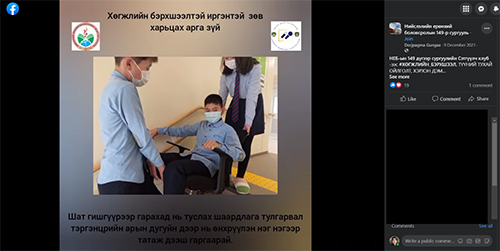 Program on understanding disabilities created by the Broadcasting Club
Program on understanding disabilities created by the Broadcasting Club
These good practices were introduced to many schools at the monitored schools' activity report seminar held on June 13, 2022. The 25 monitored schools are expected to continue to serve as model schools in the region, introducing case studies and holding training and seminars.
From September 2022, the Project will expand activities to promote inclusive education in provinces, so that the practice of inclusive education will spread to schools and kindergartens throughout the whole area of Mongolia, and they will be able to provide an environment where all kindergarten and school-age children can learn easily.
- About JICA
- News & Features
- Countries & Regions
- Our Work
- Thematic Issues
- Types of Assistance
- Partnerships with Other Development Partners
- Climate Change / Environmental and Social Considerations
- Evaluations
- Compliance and Anti-corruption
- Science and Technology Cooperation on Global Issues
- Research
- JICA Development Studies Program / JICA Chair
- Support for the Acceptance of Foreign HRs / Multicultural and Inclusive Community
- Publications
- Investor Relations
